
The Blackburnian warbler is a small New World warbler. They breed in eastern North America, from southern Canada, westwards to the southern Canadian Prairies, the Great Lakes region and New England, to North Carolina.
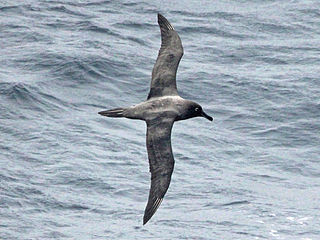
The sooty albatross is a species of marine bird belonging to the albatross family Diomedeidae. It is a medium-sized albatross that sports a sooty-brown or sooty-black color. It can be found in the southern Atlantic Ocean, the southern Indian Ocean, and the Southern Ocean. This bird scavenges for squid, fish, and carrion. Like other albatrosses, these birds mate for life and return to the same breeding spots every season. A single pair will mate every other year on a variety of islands in the southern Atlantic Ocean and the southern Indian Ocean islands. This bird is an endangered species and conservation efforts are taking place.

Nepenthes fusca, or the dusky pitcher-plant, is a tropical pitcher plant endemic to Borneo. It is found throughout a wide altitudinal range and is almost always epiphytic in nature, primarily growing in mossy forest.

Nepenthes stenophylla, or the narrow-leaved pitcher-plant, is a tropical pitcher plant endemic to Borneo. The species produces attractive funnel-shaped pitchers up to 25 cm high. It is listed as Least Concern on the IUCN Red List. Nepenthes stenophylla belongs to the loosely defined "N. maxima complex", which also includes, among other species, N. boschiana, N. chaniana, N. epiphytica, N. eymae, N. faizaliana, N. fusca, N. klossii, N. maxima, N. platychila, and N. vogelii.

Nepenthes vogelii is a tropical pitcher plant endemic to Borneo. It is thought to be most closely related to N. fusca.
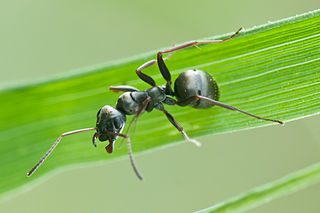
Formica fusca is a black-colored ant commonly found throughout Europe as well as parts of southern Asia and Africa. It has the common names silky ant or dusky ant. The range within the palaearctic region extends from Portugal in the west to Japan in the east and from Italy in the south to Fennoscandia in the north. Populations from North America have been split off as a separate species, Formica subaenescens. F. fusca nests are usually found in rotten tree stumps or under stones in clearcut areas and along woodland borders and hedgerows.

Nothofagus fusca, commonly known as red beech is a species of southern beech, endemic to New Zealand, occurring on both the North and South Island. It is generally found on lower hills and inland valley floors where soil is fertile and well drained. In New Zealand the species is called Fuscospora fusca.

Nepenthes chaniana is a tropical pitcher plant species belonging to the genus Nepenthes. It is characterised by a dense indumentum of long, white hairs. Pitchers are cylindrical and mostly white to yellow in colouration. Nepenthes chaniana belongs to the loosely defined "N. maxima complex", which also includes, among other species, N. boschiana, N. epiphytica, N. eymae, N. faizaliana, N. fusca, N. klossii, N. maxima, N. platychila, N. stenophylla, and N. vogelii.
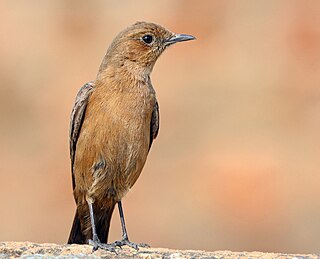
The brown rock chat or Indian chat is a bird species of the family Muscicapidae. It is found mainly in northern and central India. It is often found on old buildings and rocky areas. It resembles a female Indian robin but lacks the reddish vent and differs in posture and behaviour apart from being larger. In flight it bears some resemblance to thrushes and redstarts. It feeds on insects, captured mainly on the ground. It was formerly placed as the sole species in the genus Cercomela but is now included with the wheatears in the genus Oenanthe.

The fuscous honeyeater is a species of bird in the family Meliphagidae. It is endemic to eastern Australia, where it inhabits subtropical and tropical dry forests.
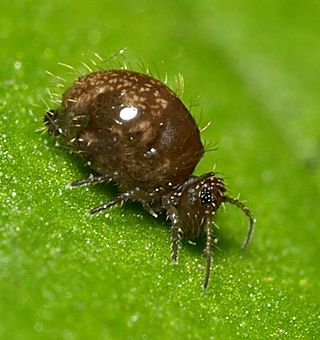
Allacma fusca is a species of springtail. This species is endemic to western areas of Continental Europe and the British Isles, where it lives in the surface layers of the soil in moist habitats such as among leaf litter.

The Myanmar brown leaf turtle is a species of Asian leaf turtle found in Myanmar.
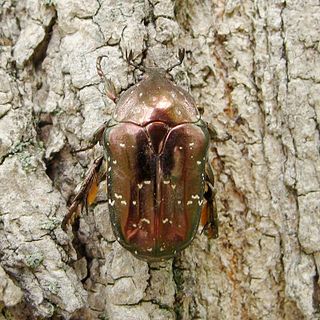
Protaetia is a genus of beetles of the family Scarabaeidae, occurring primarily in Asia, and containing over 300 species.

Dioxycanus fusca is a species of moth of the family Hepialidae. It is endemic to New Zealand. This species was first described by Alfred Philpott in 1914 as Porina fusca using specimens collected by C. Fenwick and M. O. Pasco. In 1966 L. J. Dumbleton reviewed New Zealand Hepialinae and placed this species within the genus Dioxycanus, giving it the new combination Dioxycanus fuscus.

Protaetia affinis is a species of beetle of the family Scarabaeidae.
Protaetia elegans is a species of flower chafers, scarab beetles in the subfamily Cetoniinae. It is found in Taiwan.

Protaetia lugubris is a species of beetle belonging to the family Cetoniidae.

Protaetia alboguttata is a species of flower chafer found in India, Nepal and Sri Lanka,

Protaetia cuprea, also known as the copper chafer, is a species of chafer in the family Scarabaeidae. This species is also known as the rose chafer, and has a wide geographic distribution extending from Canary Islands, Portugal and Spain in the west towards Vladivostok in the Russian Far East, Mongolia, and northern China. This species forages for pollen from flowers and fruits, such as apples, from trees. However, since fruit is scarce in the spring and winter, they only transition from a diet of pollen to a diet of fruits in the summer. Since pollen is more rich in proteins and lipids than carbohydrates, and fruit is more rich in carbohydrates, they are able to travel longer when on a fruit diet. This is due to their increased aerobic performance when fueled by carbohydrate rich content.



















